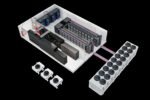Zebra Technologies explains that in today’s scenario, how technologies such as mobile devices or head-mounted displays play a key role in a robust supply chain by enabling retailers to deliver essential goods to customers.
 With today’s current situation, meeting the needs of the on-demand economy has never been more challenging for retailers: the rapidly increasing and sudden demand for everyday goods, such as bread, eggs and even toilet paper, has created substantial worldwide shortages. While the supply chain is used to being prepared for consumption peaks during winter holidays and sales periods, the current situation creates significant challenges. With the rising volume of demand and the lack of available workforce, the supply chain must be robust and flexible to continue delivering essential goods to customers.
With today’s current situation, meeting the needs of the on-demand economy has never been more challenging for retailers: the rapidly increasing and sudden demand for everyday goods, such as bread, eggs and even toilet paper, has created substantial worldwide shortages. While the supply chain is used to being prepared for consumption peaks during winter holidays and sales periods, the current situation creates significant challenges. With the rising volume of demand and the lack of available workforce, the supply chain must be robust and flexible to continue delivering essential goods to customers.
Warehouse staff are key to that flexibility including how they can be quickly onboarded with the tools they will use to be productive. Android mobile devices can help to speed up the training and onboarding of new warehouse workers. With a familiar user interface, mobile computer users are getting up to speed faster to do their jobs. This gives retailers and logistics companies extra agility to adapt to the ongoing customer needs for essential goods.
Where can technology play a role here?
Android-based mobile computers give workers the intelligence needed to speed through tasks accurately –crucial in today’s fast-moving warehousing environment. Devices are typically used 24/7/365 by shift workers in fast-paced warehouses where ‘seconds matter’. Mobile devices must have bigger batteries than traditional enterprise-grade mobile computers as they need to run for much longer before a hot swap or recharge is required. Each second of downtime can impact the flow of just-in-time fulfillment operations and reduce the pick rate. Devices must also be able to facilitate very fast data capture without compromising information accuracy, which is why mobile computers’ scanning capabilities are crucial to improve productivity and efficiency.
Many enterprise-grade mobile computers can’t read barcodes from long distances. This can quickly become an issue for warehouse workers who scan barcodes from up to 70 feet away and close-up items, while forklift drivers may need to be able to do this from an aisle or bin location from their vehicles.
Additionally, not all enterprise-grade or ‘rugged’ devices are built to withstand constant or prolonged exposure to cold-chain freezing temperatures. This is where using the right device is key, such as a freezer-friendly model that includes a heated scanner exit window, a freezer-rated battery and a Class 1 Division 2 (C1D2) non-incendive model. However, these aren’t the only types of warehouse environments or applications.
The use of mobile devices reaches far beyond scanning, with growing numbers implementing Artificial Intelligence (AI) and Augmented Reality (AR). Currently, these technologies are relegated to smaller use-cases, most widely used on mobile computers and tablets. However, increasingly people are looking at how enterprise-class, head-mounted displays can be integrated. By using smart glasses, workers can navigate warehouses, manage stock levels and quickly define tasks, all completely hands free to select products and physically place them on carts.
Once products are picked sorted and packed at the warehouse, the next challenge is to facilitate customer delivery or collection. Increasingly we see collection as a preferred fulfilment method for shoppers. Mobile technologies that enable drive up and mobile pick up are critical to ensure customers can not only obtain the things they need but can get them in a way that limits personal contact. By deploying the right solutions at the edge of the enterprise, this facilitates warehouse workers’ efficiency and improves operational workflows during these current times of unprecedent challenges.











